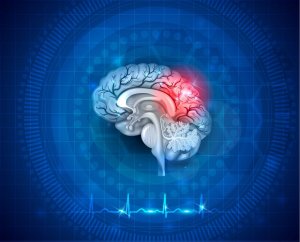First Aid for Strokes

A stroke occurs when there’s bleeding in the brain or when blood flow doesn’t circulate properly to it. As a result, within a few minutes, the brain starts to fail because essential nutrients aren’t reaching the neurons. It’s crucial to seek immediate medical attention as soon as someone has a stroke. It’s a serious medical emergency. The sooner professional treatment can be given, the less chance there will be permanent damage. However, there are also a few first aid procedures that can help while you’re waiting for help.
First aid for strokes: The “FAST” test

If you think you or someone may be about to suffer from a stroke, use the “FAST” test to remember the warning signs:
- Face: Does one side of the person’s face “fall” when they try to smile?
- Arms: Does one arm fall much lower than the other when the person tries to lift both arms?
- Speech: Can the person repeat a simple sentence? Or do they slur their words? Are they difficult to understand?
- Time: In the event of a stroke, every minute is precious. Call the emergency services immediately.
The following symptoms are also signs that a person is about to suffer a stroke. Some are:
- Weakness or numbness on one side of the body.
- Blurred or loss of vision, particularly in one eye.
- An unexpected severe headache.
- Dizziness, instability, or fainting.
Other first aid procedures
First, when the person is unconscious or isn’t responsive, they need to be placed face-up with their chin raised using one hand. You also need to check that they’re breathing by placing your ear close to their mouth, listening to the chest and trying to feel the breath. If they aren’t breathing, you need to try to resuscitate them.
CPR first aid for strokes

Cardiopulmonary resuscitation is a life-saving procedure performed on someone in cardiac arrest. It’s good to take a first aid course so that you know the correct maneuvers. However, knowing the basic techniques of CPR is useful for everyone, since an emergency can happen at the most unexpected moment and anyone can be a victim.
There are two stages to CPR that alternate:
- Chest compressions: This maintains blood flow.
- Mouth to mouth: This ensures the victim still receives oxygen.
Chest compressions happen first so that blood continues to flow to the organs:
- To do this, you need to kneel next to the person and place the heel of the hand- the carpus- in the center of their chest.
- Then, place your other hand on top, linking fingers. Using a 100 to 120 compressions per minute rhythm, you need to do 30 compressions.
- Next, you have to perform mouth to mouth. You need to breathe into their mouth twice and check enough air is entering their lungs by seeing if their chest inflates.
- Keep repeating these steps until the person is revived or professional help arrives.
This may interest you: How to resuscitate a baby
What not to do before a stroke
Many times, to help the victim, we do things to make the situation worse. Don’t try to ease the symptoms. This could be a waste of time. Don’t give a person experiencing a potential cardiovascular event any food or drink.
How to prevent a stroke
As always, when it comes to health, prevention is key. Some risk factors for a cardiovascular event are:
- High blood pressure,
- Having previously had a stroke,
- Smoking,
- Any type of diabetes,
- Suffering from heart conditions,
- Age.
Therefore, the best way to prevent strokes is to avoid the above risk factors and other harmful habits. For example, as well as quitting smoking, you should also try to stop drinking and never self-medicate. Additionally, it’s important to maintain a healthy weight, exercise at least 30 minutes daily and eat a balanced diet. Another tip is to check your blood pressure regularly, as well as your blood glucose and cholesterol levels.
One final recommendation is to get regular health checks. At least once a year or every six months for people advancing in age. If a doctor has given you a treatment plan, you must follow it to the T.
All cited sources were thoroughly reviewed by our team to ensure their quality, reliability, currency, and validity. The bibliography of this article was considered reliable and of academic or scientific accuracy.
- García, M. de la P., Morlans, L., & Sanjoaquin, A. C. (2011). Accidente cerebrovascular. In Manual del residente en geriatría. https://doi.org/10.1111/j.1462-2920.2010.02190.x
- Ruiz-Giménez Arrieta, N., González Ruano, P., & Suárez, C. (2002). Abordaje del accidente cerebrovascular. Información Terapéutica Del Sistema Nacional de Salud.
- Moyano Vera, A. (2010). El accidente cerebrovascular desde la mirada del rehabilitador. Hospital Clínico Universitario Chile.
- Mayo Clinic. (2019). Reanimación cardiopulmonar: primeros auxilios. Retrieved 31 May 2020, from https://www.mayoclinic.org/es-es/first-aid/first-aid-cpr/basics/art-20056600
- MedlinePlus. (2018). Accidente cerebrovascular: MedlinePlus enciclopedia médica. Retrieved 31 May 2020, from https://medlineplus.gov/spanish/ency/article/000726.htm
- MedlinePlus. (2018). Primeros auxilios en caso de ataque cardíaco: MedlinePlus enciclopedia médica. Retrieved 31 May 2020, from https://medlineplus.gov/spanish/ency/article/000063.htm
This text is provided for informational purposes only and does not replace consultation with a professional. If in doubt, consult your specialist.








